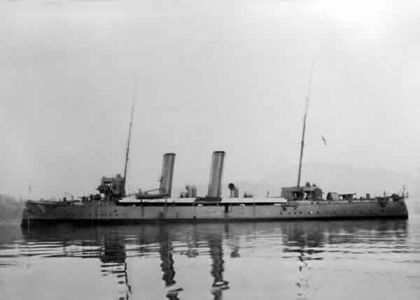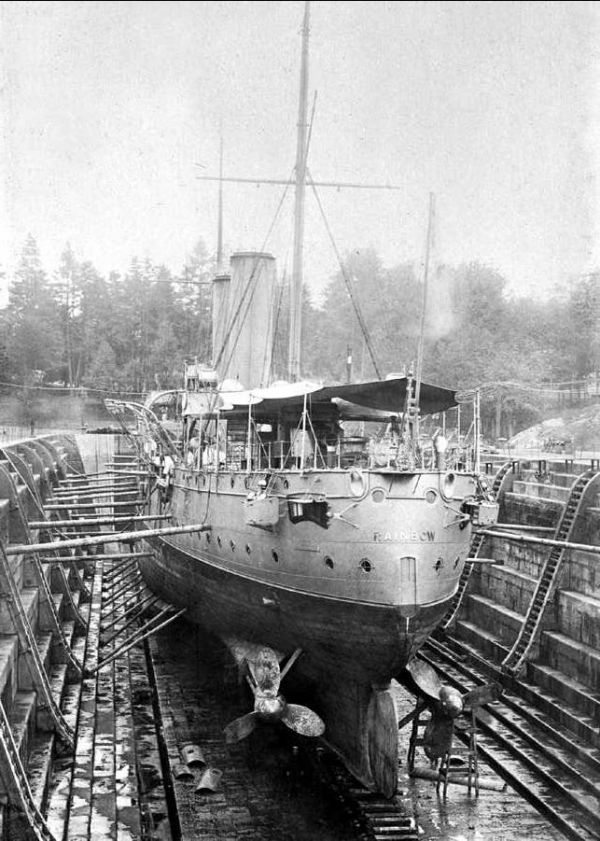Timeline: 1910-1919
HMCS RAINBOW
|
1910-1919
|
|||||||||||||||||
|
|||||||||||||||||
On the 4th of August 1910, the first unit of the fledgling Canadian Naval Service was commissioned into the RCN at Portsmouth, England. She was a light cruiser of the APOLLO Class of the RN.
The
term 'cruiser', originally spelt 'cruizer' was at first any ship,
often a frigate, detached from a fleet for independent reconnaissance.
The important similarity of such ships was that they be fast. With
the advent of steam propulsion and armour plating in the 19th century,
cruisers became a generic type of warship in their own right. Filling
roughly the place of the frigate in the sailing navies, strong but
swift cruisers were built in several categories. The biggest were
the Armoured Cruisers of about 16,000 tons; then came the Belted
Cruisers; the second class cruiser (with only very light armour)
and finally the light cruisers which had virtually no armour at
all. The APOLLO class ships were an offshoot of the development
of the Battle-Cruiser, the armoured and protected cruisers, and
descended directly from the 'belted' cruisers. 'Armoured' or 'heavily
protected cruisers', such as NIOBE, were larger ships, and had large
amounts of armour which contributed to their weight of 11,000+ tons.
RAINBOW on the other hand, was one of two branches of the cruiser
tree. All had the armoured 'Citadel', but in the case of the RAINBOW,
the guns on deck were completely without protection or at best fitted
with light shields. Apart from that, the ship was fitted with a
light 'belt' of armour and only her magazines were armoured. These
'belted' cruisers, in order to achieve higher speeds, were gradually
developed into the 'small' cruiser and finally the 'light' cruiser.
'Armoured' cruisers, even more substantial than NIOBE, were fitted
with gun casements or turrets which were heavily armoured.

HMCS RAINBOW, 1910.
Built by Palmers at Hebburn-On-Tyne in England, she was launched on the 25th of March 1891. Weighing in at 3,600 tons, she was 314' long, had a beam of 43.5' and a draught of 17.5'. She mounted 2-6" guns, 2-4.7" guns, 8-6 pounders and either 2 or 4-14" torpedo tubes (depending on the information source). She had a crew complement of around between 273 and 300. She had a design speed of 19.75 knots and her engines, when new, put out about 9,000 hp.
At the beginning of WWI, she was the only allied warship to protect the western coast of North America. During the war she patrolled the entire coast, sometimes as far as Panama, in search of German warships and shipping, scouted the BC coastal waters to ensure that no German auxiliaries such as colliers were hiding or spying on ship movements, and ended up transporting some $140,000,000.00 in Russian gold bullion between Japanese ships in Esquimalt and Barkley Sound and Vancouver.
By early 1917, NSHQ was having difficulties managing the east coast patrols. Since RAINBOW was in need of extensive repair and refit, she was paid off and her crew transferred to the patrols. By this time both the Japanese and the US had taken over naval patrol of the Pacific. She performed her last duties of war service by training gunners for patrol vessels, and was paid of on May 8th, 1917.
She
reverted to disposal on June 30th 1917, but was recommissioned as
a depot ship on July 5th. Paid off again on June 1st, 1920, she
was sold to a Seattle ship-breaker, ostensibly for use as a freighter.

HMCS RAINBOW undergoing conversion to depot ship, Esquimalt, B.C.
